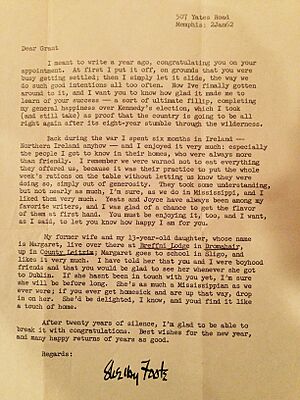Shelby Foote facts for kids
Quick facts for kids
Shelby Foote
|
|
|---|---|
 |
|
| Born | Shelby Dade Foote Jr. November 17, 1916 Greenville, Mississippi, U.S. |
| Died | June 27, 2005 (aged 88) Memphis, Tennessee, U.S. |
| Occupation |
|
| Alma mater | University of North Carolina Chapel Hill |
| Subjects | American Civil War |
| Notable works | The Civil War: A Narrative |
| Spouse |
Tess Lavery
(m. 1944; div. 1946)Marguerite "Peggy" Desommes
(m. 1948; div. 1952)Gwyn Rainer
(m. 1956) |
| Children | 2 |
Shelby Dade Foote Jr. (born November 17, 1916 – died June 27, 2005) was an American writer and historian. He saw himself mainly as a novelist. However, he is best known for writing The Civil War: A Narrative. This was a three-volume history of the American Civil War.
Shelby Foote grew up in the Mississippi Delta. His life and writing showed the big changes happening in the South. This included the shift from old farming ways to the Civil Rights Movement. Many people did not know about Foote until he appeared in Ken Burns's PBS show The Civil War in 1990. He helped a new generation understand the war. He believed it was "central to all our lives." Foote wrote all his books by hand using a nib pen. Then he typed them up.
Contents
Early Life and Education
Shelby Foote was born in Greenville, Mississippi. His father was Shelby Dade Foote and his mother was Lillian. His grandfather had lost most of his family's money. His great-grandfather was a Confederate soldier and politician. Foote's mother's father was a Jewish immigrant from Vienna.
Foote was raised in the Episcopal faith. He also went to synagogue with his mother until he was eleven. His family moved often because of his father's job. They lived in Mississippi, Florida, and Alabama. Foote's father died when Shelby was five. He and his mother moved back to Greenville.
When Foote was 15, he became friends with Walker Percy. They had a strong friendship and helped each other with their writing. Foote was also influenced by famous writers like Tacitus and Gibbon. He edited his high school newspaper. He often made fun of the principal in his articles.
In 1935, Foote applied to the University of North Carolina at Chapel Hill. He was first turned down. But he took tests and was accepted. He joined the Alpha Tau Omega fraternity. Foote loved learning but did not focus on getting a degree. He spent a lot of time in the library. He also wrote stories for the school's literary magazine. In 1937, he returned to Greenville. He worked in construction and for a local newspaper. Around this time, he started writing his first novel.
Military Service and Early Career
In 1940, Foote joined the Mississippi National Guard. He became a captain in the artillery. In 1943, his group went to Northern Ireland. The next year, Foote was charged with faking a document. This was about a car he borrowed to visit a girlfriend. He was removed from the army.
After this, Foote worked for the Associated Press in New York City. In 1945, he joined the United States Marine Corps. He was discharged as a private later that year. He never saw combat.
Foote then went back to Greenville. He worked at a radio station but spent most of his time writing. He sent part of his first novel to The Saturday Evening Post. It was published in 1946. When he got paid, he quit his job to write full-time.
Becoming a Novelist
Foote's first novel, Tournament, came out in 1949. It was inspired by his grandfather. For his next book, Follow Me Down (1950), Foote used details from a murder trial he had attended.
Love in a Dry Season (1951) was about the upper classes in the Mississippi Delta during the Great Depression. Foote liked this novel very much. In Shiloh (1952), Foote wrote about the Battle of Shiloh. This was one of the bloodiest battles in American history. He told the story from the point of view of seven different soldiers. The book sold well and got good reviews. Later, some historians said Foote favored the South in the novel. They felt he did not mention slavery enough.
Jordan County: A Landscape in Narrative (1954) was a collection of stories. They were set in a made-up Mississippi county. September, September (1978) was about three white Southerners who kidnap a wealthy African American boy. This story was set in Memphis in 1957.
Foote said it was hard for him to write realistic African-American characters. He avoided them until September, September. Other writers like Eudora Welty and William Faulkner admired Foote's fiction. Faulkner once told a class that Foote "shows promise."
During the 1950s and 1960s, Foote supported civil rights. He was against school segregation. He also supported Presidents John F. Kennedy and Lyndon Johnson. Foote protested against the Ku Klux Klan using the Confederate flag. He believed their ideas were the opposite of what the Confederacy stood for.
Becoming a Historian
In 1952, Foote moved to Memphis. He planned to write a big novel called Two Gates to the City. But he found it hard to make progress. Then, he got a letter from Bennett Cerf of Random House. Cerf asked him to write a short history of the Civil War. This was for the war's 100th anniversary. Cerf was impressed by the facts in Foote's novel Shiloh.
Foote had no training in academic history. He did not use footnotes or archives. Instead, he visited battlefields. He read many books and used the 128-volume Official Records of the War of the Rebellion. Foote called himself a "novelist-historian." He said he used a novelist's methods but followed a historian's rules. He did not use footnotes because he felt they would interrupt the story. He wanted readers to feel like they were experiencing the war.
Foote realized the project needed to be bigger. He asked for it to be three volumes, each very long. He thought it would take nine years. His plan was approved. He then started writing his big, three-volume history, The Civil War: A Narrative. The books were:
- Fort Sumter to Perryville (1958)
- Fredericksburg to Meridian (1963)
- Red River to Appomattox (1974)
Foote worked on this history for twenty years. He supported himself with grants and loans from Walker Percy.
Views on Race and Later Life
Foote had complex views on race. He supported the Civil Rights Movement in the South. He believed African Americans should be treated with respect. He said the South was "perhaps the most racist society in the United States."
However, in later years, some of Foote's comments became controversial. He believed that African Americans should model themselves on Jewish people in terms of making money. He also said that the Ku Klux Klan of the 1920s was "mostly anti-Catholic." Foote felt he understood historical figures like Nat Turner better than some Northern African-American thinkers.
In the late 1980s, Ken Burns asked Foote to be part of his Civil War documentary. Foote became a key voice in the film. His Southern accent and storytelling made him famous. However, some historians criticized him. They said he repeated "Lost Cause" ideas. These ideas downplayed slavery's role in the war. Foote believed slavery was not the only cause of the Civil War. He said soldiers fought for other reasons.
Foote became a reluctant celebrity. His phone number was listed, and he got many calls from viewers. He never unlisted it. He was a charter member of the Fellowship of Southern Writers. In 1992, he received an honorary doctorate from the University of North Carolina. He also helped oppose a Disney theme park near Civil War battlefields in Virginia.
In 1998, Foote told author Tony Horwitz that he would have fought for the Confederacy. He said, "I’d be with my people, right or wrong." He believed the Confederate flag represented "law, honour, love of country."
Foote died in Memphis on June 27, 2005, at age 88. He was buried in Elmwood Cemetery. His grave is near the family plot of General Nathan Bedford Forrest.
Legacy and Impact
Many people praised the writing style of The Civil War: A Narrative. But academic reviewers often pointed out that it lacked footnotes. They also noted that Foote did not focus on social or economic issues.
In 1993, historian Richard N. Current said Foote's work was likely as accurate as most historians'. He believed Foote's history would be remembered as a classic.
In 2011, writer Ta-Nehisi Coates said Foote did not understand the Civil War's true meaning. Coates felt Foote could not see the war from the perspective of enslaved people.
In 2013, the Sons of Confederate Veterans used Foote's description of Nathan Bedford Forrest. Foote had called Forrest a "humane slave holder." This was used to protest the removal of Forrest's statue in Memphis.
In 2017, John F. Kelly, a White House official, said a "lack of ability to compromise" caused the Civil War. He also called Robert E. Lee an "honorable man." The White House Press Secretary cited Foote's work to support Kelly's views.
In 2019, a Mississippi Writers Trail marker was placed in Greenville, Mississippi. It honored Shelby Foote's contributions to literature and history. Foote's unique Southern accent also inspired Daniel Craig's character in the 2019 film Knives Out.
Images for kids



